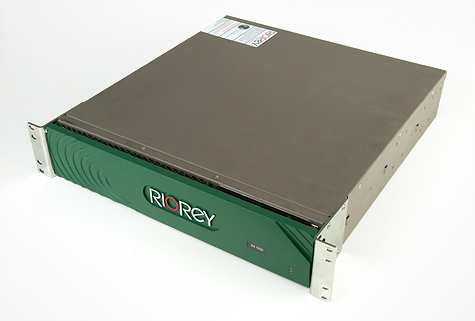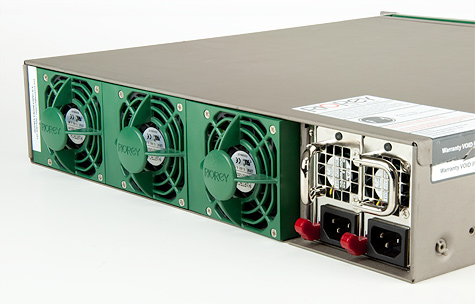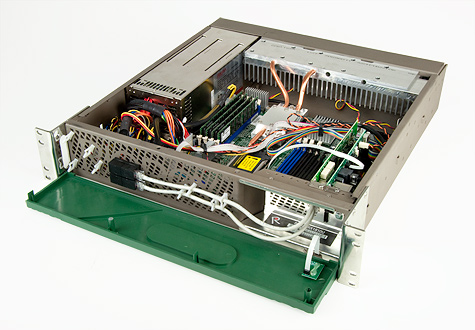The RX series consists of the models 18, 23 and 44. According to the specifications, these models only differ from one another in the amount of traffic they can handle at the moment a DDoS attack is in progress. This translates to 300kpps, 425kpps and 1.4Mpps in case of the 18, 23 and 44 models respectively. Since we usually have only limited amounts of incoming traffic, we deemed the 300kpps version sufficient. With the smallest packets of 64 bytes this big box is able to handle a good 150Mbps of traffic and with a maximum packet size of 1500 bytes it could even handle a theoretical 3.6Gbps.
The attacks we carried out were frequently above the de 350kpps, so the estimated capacity is probably on the safe side. In such cases the RioRey appliance did suffer quite a burden, though.
By the way, the RX appliances can be furnished with either a set of basic RJ45 plugs, multimode SX/LC optical fibre or single-mode LX/LC optical fibre, which results in 10, 11 or 12 as the model number postfix.
Looks
The RX1810 is a 2U rack mount without sliders. The green front with the fairly large RioRey logo is quite an eye-catcher, but the rest of the appliance looks rather basic and dull. Although we are suckers for appealing industrial design, we of course much rather have the manufacturer invest his money in decent DDoS protection ![]()

The construction is robust and professional. The only slightly weaker part is the green board that protects the connections at the front. It is kept in place by two (too) small magnets and fails to close properly even when only one of the cables comes down through the opening at ever so slight an angle.
Traffic is led through the appliance by means of two network cables. The appliance is further furnished with a serial and a network port for the management interface. To provide you with status reviews at its location the appliance has been furnished with three LEDs that indicate its status and which show whether there is a DDoS attack in progress.

The interior
Since we would really like to keep the guarantee on our brand-new RX1810 valid, we refrained from opening up the appliance. However, we were able to get a closer look at the interior of a demonstration model. Thus, we found out that the interior comes across as being both professional and reliable. Cable management is not quite as streamlined as it is in the Sun and Dell servers which we have bought recently, but everything is connected firmly and in a practical manner.

The CPU cooling is a gigantic cooling block that is placed right in front of the system fans thanks to its heat pipes. The CPU is a regular AMD Opteron dual core with an aggregate 16GB RAM. Flash memory has been installed for permanent storage.
The network card and monitoring hardware that are supplied with the RioRey are something special, but from the outside it is difficult to see what their exact function is. The network card at least comes equipped with the previously mentioned hardware bypass, which turns the appliance into a somewhat overpriced RJ45 coupler; the traffic along the cables will be put through unchecked. This mode is switched on, for example, when the appliance carries out an update or when the power is disconnected from the appliance. This way, the servers behind the RioRey are always available.
Web interface
In addition, the RX1810 comes equipped with a basic web interface. In particular, it allows you to set up the basic configuration for the management interface. Things that can be configured are the IP address and the various external servers such as NTP, SMTP, DNS, SYSLOG, RADIUS and SNMP.
It is almost refreshing to see how stripped down the interface is: it contains some basic HTML forms and tables set against a pale orange background and that is about it. The idea is that you only spend a few minutes here to configure the appliance. Afterwards, the appliance can be completely managed from the rView console.
